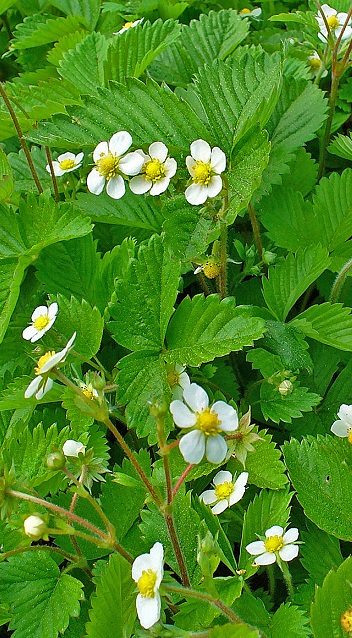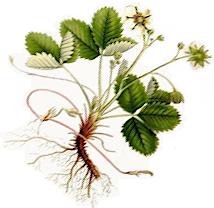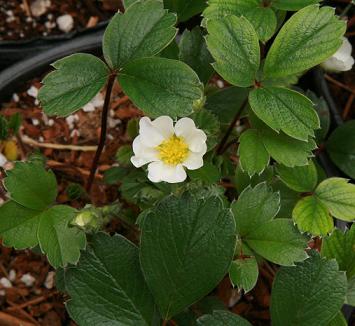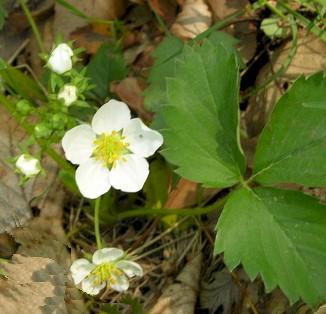|
|
|
Hansen's Northwest Native Plant Database |
|
|
|
Wild Strawberries |
||||||||||||||||||||||||||||||||||||||||||||||||||
Photo credit: H. Zell |
 |
|||||||||||||||||||||||||||||||||||||||||||||||||
|
General Information For This Genus Click on links at bottom of this page for photos and details of each plant. |
|||
|
|||
|
General Information Fresh northwest native strawberries, warm from the sun and bursting with flavor are unlike anything else on earth. Loved by birds and children of all ages, our northwest native strawberries are purely delightful picked fresh and eaten out of hand just as they are. Unlike most strawberries one may find in a store or roadside stand, these are naturally delicious instead of genetically engineered to be large or to ship well or to be a special color. These are the same strawberries folks were eating 100 years ago. Basket of Wild Strawberries (1761) Painting by Jean Baptiste Cimeon Chardin |
|
||
| As wonderful to eat as these fruits are, their landscape value may be even greater. The perfect ground cover, they travel over ground by sending out a tiny plant at the end of a "runner," just as strawberry plants have always grown. The little leaves soon become a group of threesome's, each group on it's own stem. Then the flowers emerge and bloom, fading to leave a strawberry which ripens to a rich red. In fall, the leaves turn red and they go dormant. All this activity gives the plants changing appeal as they cover bare spots in the landscape. Now, I ask you, what could be better in a native garden than a little plant that gives so much! | |||
|
Wild strawberries grow all over North America. There are 3 species and 13 recognized subspecies or variants in the genus Fragaria which are native to this continent. Common characteristics are the leaf, flower and fruit shapes, and the growth habit of producing runners. This last trait is what makes wild strawberries superb choices for groundcovers. These low growing perennials are pleasing to the eye, have lovely flavored leaves, and produce small very tasty fruits enjoyed by humans and several types of wildlife. The berries are particularly treasured by young children because they can easily spot the bright colors and are able to harvest for themselves. |
 |
||
|
Note: Other plants bearing common name of "strawberry" include the Strawberry Tree (Arbutus unedo), Indian Strawberry (Duchesnea indica), Strawberry Hedgehog Cactus (Echinocereus stramineus), strawberry bushes (Euonymus), Strawberry-Pear (Hylocereus trigonus), Strawberry Cactus (Mammillaria dioica), Strawberry Tree (Muntingia calabura), Strawberry Groundcherry (Physalis alkagenki), Strawberry-Tomato (Physalis grisea), Strawberry Cinquefoil (Potentilla fragiformis), Strawberry Guava (Psidium cattleianum), strawberry raspberries (Rubus), Strawberry Saxifrage (Saxifragopsis fragarioides), Strawberry Clover (Trifolium fragiferum), and several barren strawberries (Waldsteinia). |
|||
|
Species Information For This Genus Click on links below for photos and details of each plant. |
|||
|
As yet, not all northwest native fragaria are covered in this website, though that may be done some time in the future. For now, we have information about only three of our northwest native fragaria. |
|||
|
Fragaria chiloensis (Coastal
Strawberry)
A superb evergreen ground cover, Coastal Strawberry does well in sun or partial shade. True to its name, this strawberry is native to beach areas and other inhospitable growing sites from Alaska to Chile and in Hawaii as well (USDA 7-10). It spreads by runners to forms low, compact mats, 6 - 12" high. The leaves are leathery with red tints in winter. Large white flowers in the spring are followed by delectable berries that put store-bought berries to shame! |
 |
||
|
Fragaria vesca (Wood's Strawberry,
Woodland Strawberry)
This fine, deciduous strawberry has small, delicious fruit. Light green, sharply toothed, clover-like leaves distinguish this plant. With long runners, it spreads easily to make a nice ground cover. Found in the wild in shaded sites from southern BC to California (USDA 5-9), it is more common on the West side of the Cascades than the East side. |
|
||
|
Fragaria virginiana var. platypetala
(Wild Strawberry)
Similar to the Wood's Strawberry, bluish green top leaves distinguish this species. With its bright white flowers and delicious fruit, this deciduous, low-growing plant, reaches only 2-5” in height. Tucked among larger plants, they cover the ground to hold soil, retain moisture and keep youngsters entertained treasure hunting for the delicious berries on warm summer days. Wild strawberry is more common on the East side of the Cascades, but it is also found on the Western side. Usually occurring at higher elevations than the other Fragaria species, Wild strawberry grows on rocky slopes in full sun and often follows the path of rainwater runoff. It is hardy between USDA zones 4-10. |
 |
||
|
|||
|